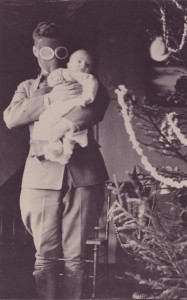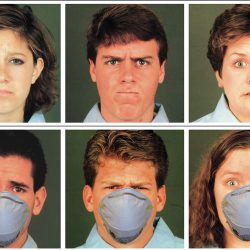Patriotism and Poison Gas

UW chemistry professor Farrington Daniels (with his son Farrington Jr. in a 1917 photo) studied ways to improve gas masks. UW Archives S13728.
While some faculty members left the UW to serve the cause on the battlefield or in government agencies, others fully engaged in the war at home.
A Patriotic Speaking Bureau sponsored 551 spirited addresses by faculty members, released war pamphlets to 400,000 people, and sent a weekly series of articles to English- and German-language newspapers around the state about the causes and issues of war. School of Music professor Edgar Gordon ’27, MA’29 organized a statewide network of “Liberty Choruses” and sent music to 230 choirs to perform at patriotic meetings.
One of the most important scientific contributions was the submarine detector developed by UW mathematician Max Mason 1898, along with physicists J. R. Roebuck and Earl Terry. Mason was a member of the submarine committee of the National Research Council. They tested their prototype in Lake Mendota, and the success of the Mason Hydrophone led to its adoption by the War Department.
Other researchers studied poison gas, the newest weapon of war. The United States lagged behind Europe in studying chemical weapons, so physiologist John Eyster organized a chemical- warfare research center, better known as the gas project, in the basement of Science Hall. Eight faculty members and 30 students, along with members of the Army Chemical Warfare Service, constructed gas chambers where they intensively studied blistering and choking agents, including chlorine, phosgene, mustard gas, and lewisite. They studied the effects of exposure to low concentrations of gases, examined the permeability of fabrics, and worked to develop protective salves for use against mustard gas.
Across campus at the U.S. Forest Products Laboratory, researchers and students worked on the production of gas masks that used charcoal as a filtering agent. This wasn’t the only war work in the lab. Researchers also tested airplane wood, studied hydro-airplane construction, researched wood substitutes for shipping goods overseas, and investigated waterproof paper, among other projects.
Published in the Spring 2017 issue



Comments
No comments posted yet.